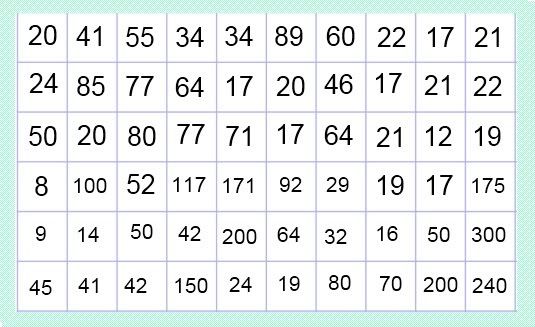Addictive Math Puzzles
Posted: Tue Feb 07, 2012 2:25 am
Hi there,
This is a type of math puzzle that I dreamt up.
(Later on I discovered that it was already discovered by others on the web, but I don't think that they also thought of the 2-D version. )
It's called "Maximum non adjacent subsequence sum".
Given an array A[..], filled with numbers *(that I chose),
your mission is to find the maximum sum of a SUBSET of array A[..]
with the constraint that no 2 numbers are adjacent to each other.
That is, - the SUM that is MAXIMUM wins and is the correct answer.
PUZZLE 1: -- Array A[..]

PUZZLE 2: -- Array B[..]

For puzzle 2, do the same thing.
Both arrays have only 16 numbers each.
Hints:
In puzzle 1, you may add the first "5" and "9" together (=14),
but you may not add that "5" to "8" since "5" and "8" are adjacent.
You may skip and choose any numbers that you wish as long as
they are not neighbors. MAXIMUM SUM wins.
Let's see how many get the correct answers for both puzzles.
There is even a slim possibility that one array will have 2 equal answers,
= a tie, but it's not likely, the odds are against it.
**************************************************
Try to solve the 2-Dimensional version:
It is a 10x6 arrray, the same rules apply,
extended UP-DOWN as well as LEFT-RIGHT.
No adjacent numbers may be summed together,
that is:
A number may not be summed with the one to its adjacent LEFT or
adjacent RIGHT.
A number may not be summed with it's immediate UP or DOWN.
The MAXIMUM SUM wins.
Any numbers chosen will have an effect on the
availability of others.
For example, in the first line, if you chose "41" then you will
not be able to choose "85" in the lower line because they are adjacent.
PUZZLE 3: -- Array C[..][..]

This is so hard that you may have to design a computer program to solve it.
This is a type of math puzzle that I dreamt up.
(Later on I discovered that it was already discovered by others on the web, but I don't think that they also thought of the 2-D version. )
It's called "Maximum non adjacent subsequence sum".
Given an array A[..], filled with numbers *(that I chose),
your mission is to find the maximum sum of a SUBSET of array A[..]
with the constraint that no 2 numbers are adjacent to each other.
That is, - the SUM that is MAXIMUM wins and is the correct answer.
PUZZLE 1: -- Array A[..]

PUZZLE 2: -- Array B[..]

For puzzle 2, do the same thing.
Both arrays have only 16 numbers each.
Hints:
In puzzle 1, you may add the first "5" and "9" together (=14),
but you may not add that "5" to "8" since "5" and "8" are adjacent.
You may skip and choose any numbers that you wish as long as
they are not neighbors. MAXIMUM SUM wins.
Let's see how many get the correct answers for both puzzles.
There is even a slim possibility that one array will have 2 equal answers,
= a tie, but it's not likely, the odds are against it.
**************************************************
Try to solve the 2-Dimensional version:
It is a 10x6 arrray, the same rules apply,
extended UP-DOWN as well as LEFT-RIGHT.
No adjacent numbers may be summed together,
that is:
A number may not be summed with the one to its adjacent LEFT or
adjacent RIGHT.
A number may not be summed with it's immediate UP or DOWN.
The MAXIMUM SUM wins.
Any numbers chosen will have an effect on the
availability of others.
For example, in the first line, if you chose "41" then you will
not be able to choose "85" in the lower line because they are adjacent.
PUZZLE 3: -- Array C[..][..]

This is so hard that you may have to design a computer program to solve it.